Business Law: Negligence, Duty of Care, and Foreseeability Case Study
VerifiedAdded on 2023/06/05
|7
|2349
|267
Case Study
AI Summary
This case study analyzes a negligence claim involving Susan, who owns a Bengal tiger named Benji. Cliff and Mary, Susan's neighbors, suffered injuries after Kim, a child, released Benji from her enclosure. The study examines whether Susan owed a duty of care to Cliff and Mary, whether she breached that duty, and whether the damages were foreseeable. It applies legal principles from cases like Donoghue v Stevenson and Overseas Tankship (UK) Ltd v Morts Dock & Engineering Co Ltd to determine if Susan is liable for negligence. The analysis concludes that Susan is not liable because she maintained a reasonable standard of care, and the damages were too remote. Defenses such as contributory negligence and voluntary assumption of risk are also considered, ultimately finding that Cliff and Mary cannot successfully sue Susan. Desklib offers similar case studies and resources for students.
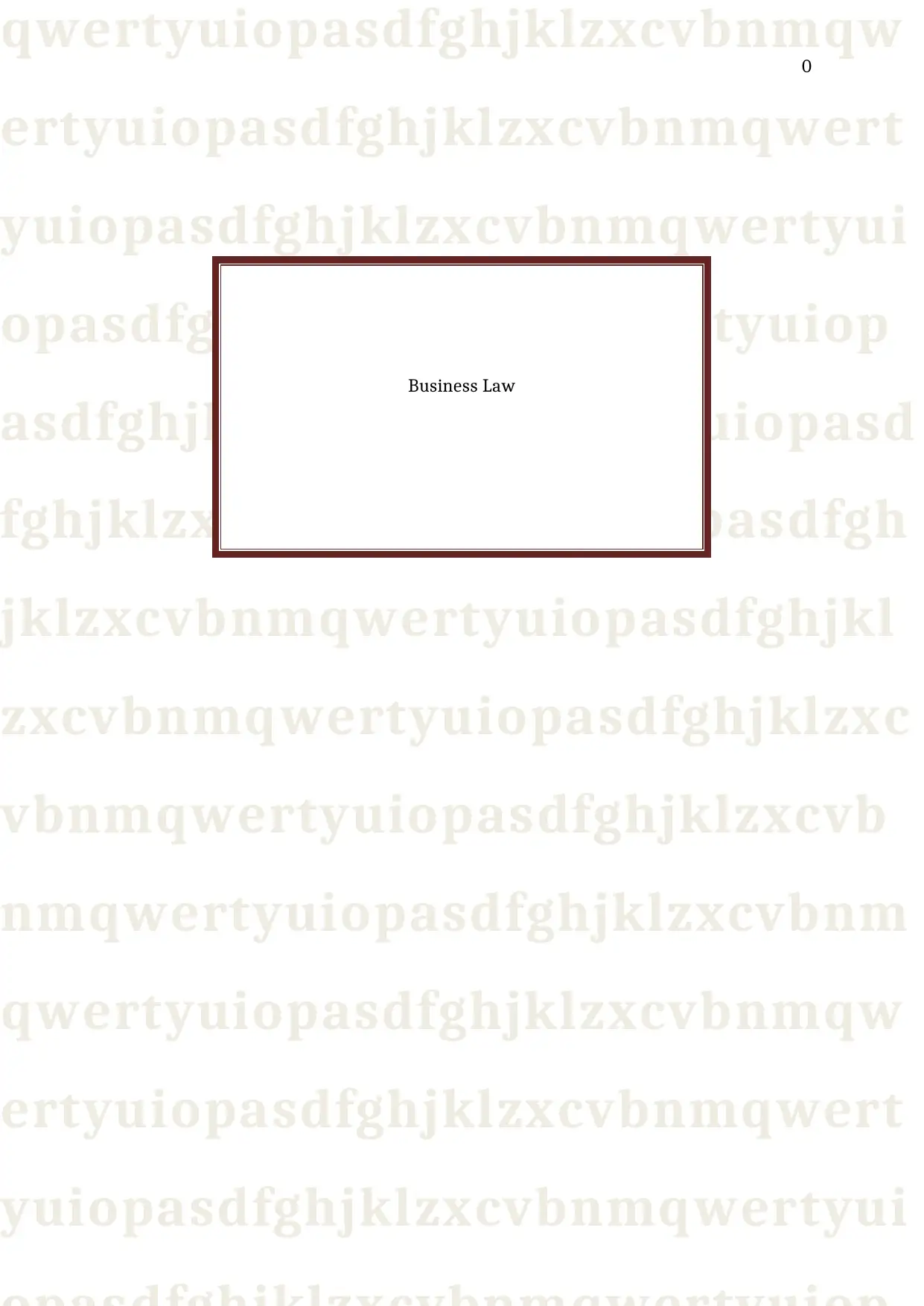
qwertyuiopasdfghjklzxcvbnmqw
ertyuiopasdfghjklzxcvbnmqwert
yuiopasdfghjklzxcvbnmqwertyui
opasdfghjklzxcvbnmqwertyuiop
asdfghjklzxcvbnmqwertyuiopasd
fghjklzxcvbnmqwertyuiopasdfgh
jklzxcvbnmqwertyuiopasdfghjkl
zxcvbnmqwertyuiopasdfghjklzxc
vbnmqwertyuiopasdfghjklzxcvb
nmqwertyuiopasdfghjklzxcvbnm
qwertyuiopasdfghjklzxcvbnmqw
ertyuiopasdfghjklzxcvbnmqwert
yuiopasdfghjklzxcvbnmqwertyui
0
Business Law
ertyuiopasdfghjklzxcvbnmqwert
yuiopasdfghjklzxcvbnmqwertyui
opasdfghjklzxcvbnmqwertyuiop
asdfghjklzxcvbnmqwertyuiopasd
fghjklzxcvbnmqwertyuiopasdfgh
jklzxcvbnmqwertyuiopasdfghjkl
zxcvbnmqwertyuiopasdfghjklzxc
vbnmqwertyuiopasdfghjklzxcvb
nmqwertyuiopasdfghjklzxcvbnm
qwertyuiopasdfghjklzxcvbnmqw
ertyuiopasdfghjklzxcvbnmqwert
yuiopasdfghjklzxcvbnmqwertyui
0
Business Law
Paraphrase This Document
Need a fresh take? Get an instant paraphrase of this document with our AI Paraphraser
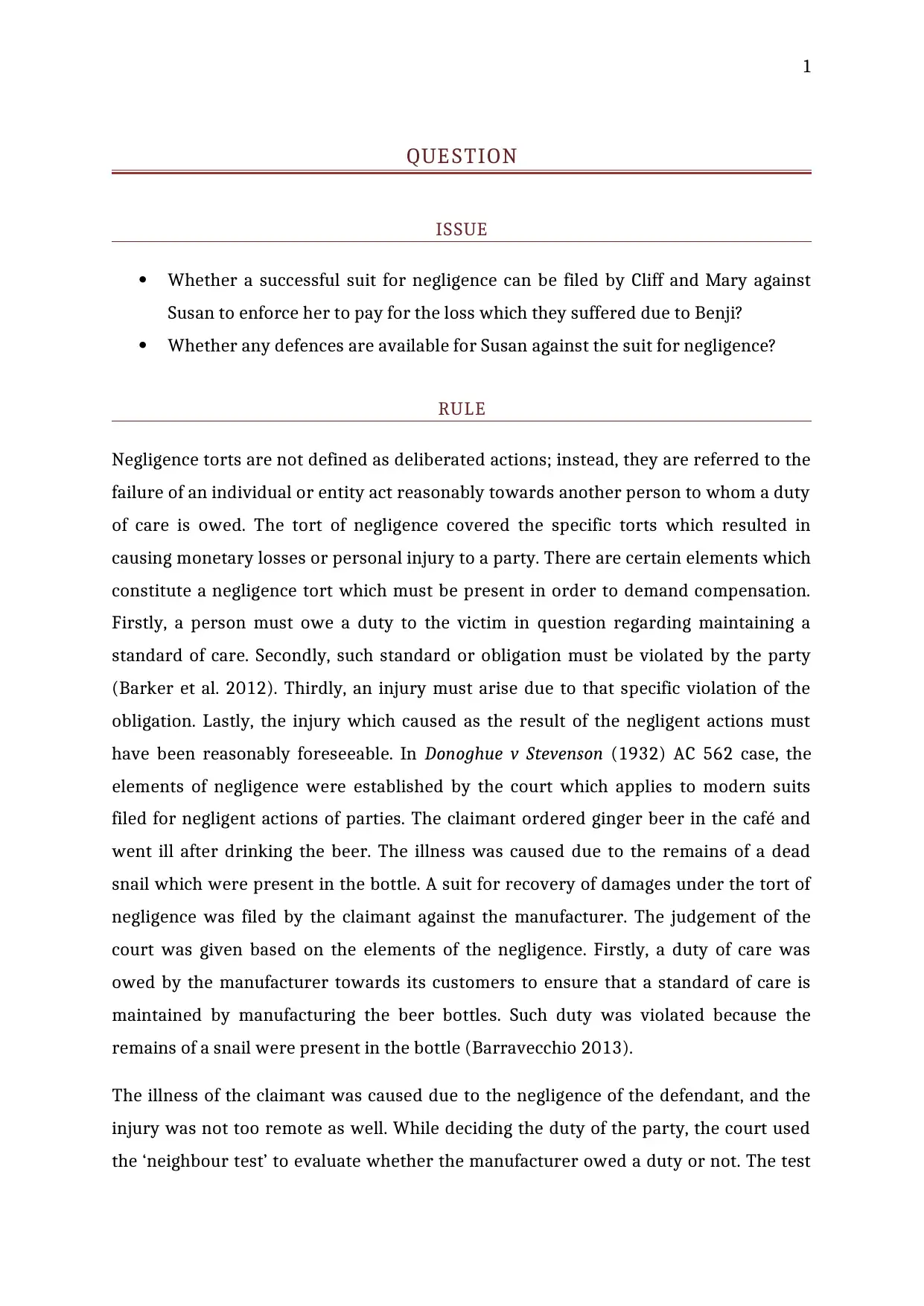
1
QUESTION
ISSUE
Whether a successful suit for negligence can be filed by Cliff and Mary against
Susan to enforce her to pay for the loss which they suffered due to Benji?
Whether any defences are available for Susan against the suit for negligence?
RULE
Negligence torts are not defined as deliberated actions; instead, they are referred to the
failure of an individual or entity act reasonably towards another person to whom a duty
of care is owed. The tort of negligence covered the specific torts which resulted in
causing monetary losses or personal injury to a party. There are certain elements which
constitute a negligence tort which must be present in order to demand compensation.
Firstly, a person must owe a duty to the victim in question regarding maintaining a
standard of care. Secondly, such standard or obligation must be violated by the party
(Barker et al. 2012). Thirdly, an injury must arise due to that specific violation of the
obligation. Lastly, the injury which caused as the result of the negligent actions must
have been reasonably foreseeable. In Donoghue v Stevenson (1932) AC 562 case, the
elements of negligence were established by the court which applies to modern suits
filed for negligent actions of parties. The claimant ordered ginger beer in the café and
went ill after drinking the beer. The illness was caused due to the remains of a dead
snail which were present in the bottle. A suit for recovery of damages under the tort of
negligence was filed by the claimant against the manufacturer. The judgement of the
court was given based on the elements of the negligence. Firstly, a duty of care was
owed by the manufacturer towards its customers to ensure that a standard of care is
maintained by manufacturing the beer bottles. Such duty was violated because the
remains of a snail were present in the bottle (Barravecchio 2013).
The illness of the claimant was caused due to the negligence of the defendant, and the
injury was not too remote as well. While deciding the duty of the party, the court used
the ‘neighbour test’ to evaluate whether the manufacturer owed a duty or not. The test
QUESTION
ISSUE
Whether a successful suit for negligence can be filed by Cliff and Mary against
Susan to enforce her to pay for the loss which they suffered due to Benji?
Whether any defences are available for Susan against the suit for negligence?
RULE
Negligence torts are not defined as deliberated actions; instead, they are referred to the
failure of an individual or entity act reasonably towards another person to whom a duty
of care is owed. The tort of negligence covered the specific torts which resulted in
causing monetary losses or personal injury to a party. There are certain elements which
constitute a negligence tort which must be present in order to demand compensation.
Firstly, a person must owe a duty to the victim in question regarding maintaining a
standard of care. Secondly, such standard or obligation must be violated by the party
(Barker et al. 2012). Thirdly, an injury must arise due to that specific violation of the
obligation. Lastly, the injury which caused as the result of the negligent actions must
have been reasonably foreseeable. In Donoghue v Stevenson (1932) AC 562 case, the
elements of negligence were established by the court which applies to modern suits
filed for negligent actions of parties. The claimant ordered ginger beer in the café and
went ill after drinking the beer. The illness was caused due to the remains of a dead
snail which were present in the bottle. A suit for recovery of damages under the tort of
negligence was filed by the claimant against the manufacturer. The judgement of the
court was given based on the elements of the negligence. Firstly, a duty of care was
owed by the manufacturer towards its customers to ensure that a standard of care is
maintained by manufacturing the beer bottles. Such duty was violated because the
remains of a snail were present in the bottle (Barravecchio 2013).
The illness of the claimant was caused due to the negligence of the defendant, and the
injury was not too remote as well. While deciding the duty of the party, the court used
the ‘neighbour test’ to evaluate whether the manufacturer owed a duty or not. The test
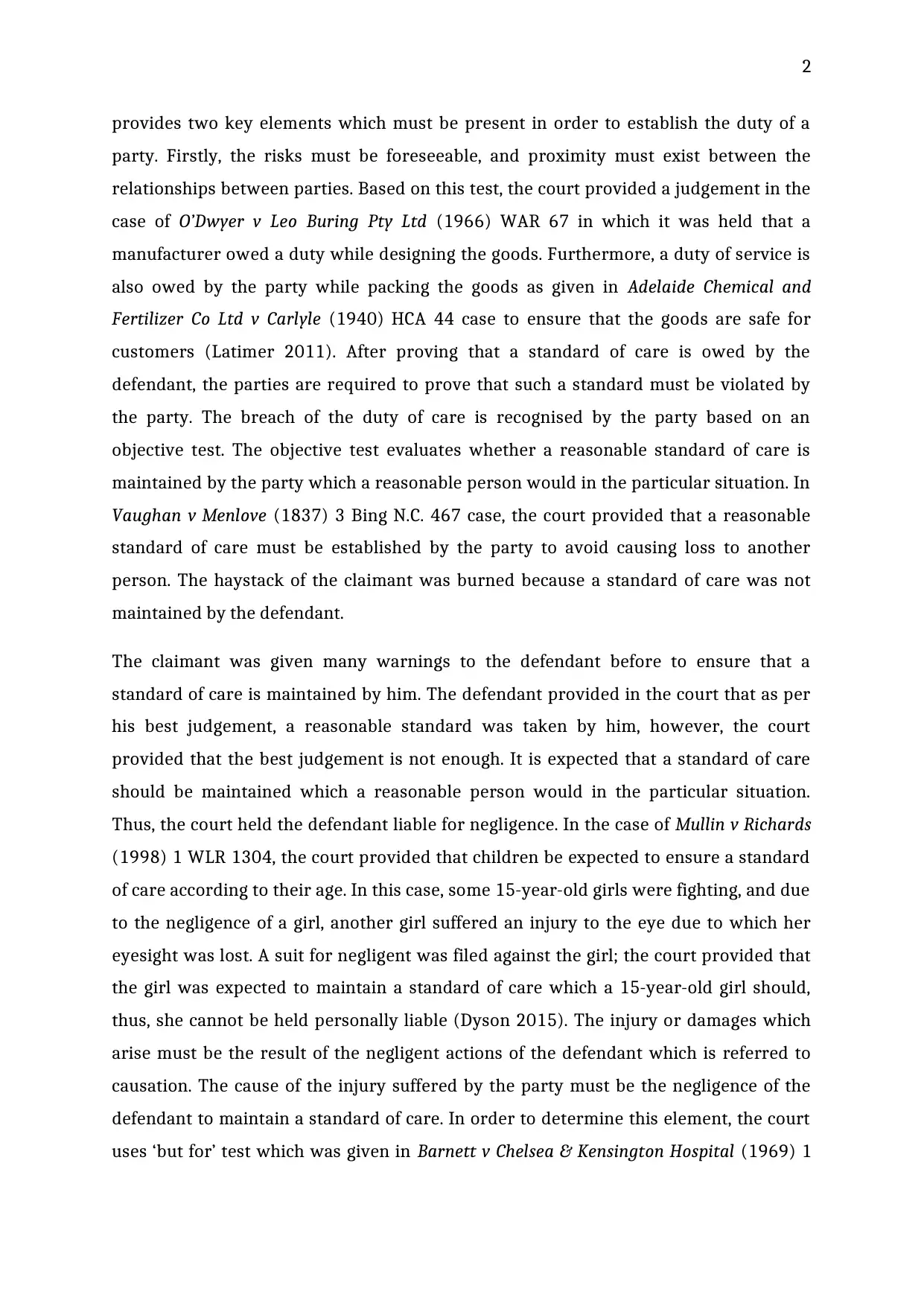
2
provides two key elements which must be present in order to establish the duty of a
party. Firstly, the risks must be foreseeable, and proximity must exist between the
relationships between parties. Based on this test, the court provided a judgement in the
case of O’Dwyer v Leo Buring Pty Ltd (1966) WAR 67 in which it was held that a
manufacturer owed a duty while designing the goods. Furthermore, a duty of service is
also owed by the party while packing the goods as given in Adelaide Chemical and
Fertilizer Co Ltd v Carlyle (1940) HCA 44 case to ensure that the goods are safe for
customers (Latimer 2011). After proving that a standard of care is owed by the
defendant, the parties are required to prove that such a standard must be violated by
the party. The breach of the duty of care is recognised by the party based on an
objective test. The objective test evaluates whether a reasonable standard of care is
maintained by the party which a reasonable person would in the particular situation. In
Vaughan v Menlove (1837) 3 Bing N.C. 467 case, the court provided that a reasonable
standard of care must be established by the party to avoid causing loss to another
person. The haystack of the claimant was burned because a standard of care was not
maintained by the defendant.
The claimant was given many warnings to the defendant before to ensure that a
standard of care is maintained by him. The defendant provided in the court that as per
his best judgement, a reasonable standard was taken by him, however, the court
provided that the best judgement is not enough. It is expected that a standard of care
should be maintained which a reasonable person would in the particular situation.
Thus, the court held the defendant liable for negligence. In the case of Mullin v Richards
(1998) 1 WLR 1304, the court provided that children be expected to ensure a standard
of care according to their age. In this case, some 15-year-old girls were fighting, and due
to the negligence of a girl, another girl suffered an injury to the eye due to which her
eyesight was lost. A suit for negligent was filed against the girl; the court provided that
the girl was expected to maintain a standard of care which a 15-year-old girl should,
thus, she cannot be held personally liable (Dyson 2015). The injury or damages which
arise must be the result of the negligent actions of the defendant which is referred to
causation. The cause of the injury suffered by the party must be the negligence of the
defendant to maintain a standard of care. In order to determine this element, the court
uses ‘but for’ test which was given in Barnett v Chelsea & Kensington Hospital (1969) 1
provides two key elements which must be present in order to establish the duty of a
party. Firstly, the risks must be foreseeable, and proximity must exist between the
relationships between parties. Based on this test, the court provided a judgement in the
case of O’Dwyer v Leo Buring Pty Ltd (1966) WAR 67 in which it was held that a
manufacturer owed a duty while designing the goods. Furthermore, a duty of service is
also owed by the party while packing the goods as given in Adelaide Chemical and
Fertilizer Co Ltd v Carlyle (1940) HCA 44 case to ensure that the goods are safe for
customers (Latimer 2011). After proving that a standard of care is owed by the
defendant, the parties are required to prove that such a standard must be violated by
the party. The breach of the duty of care is recognised by the party based on an
objective test. The objective test evaluates whether a reasonable standard of care is
maintained by the party which a reasonable person would in the particular situation. In
Vaughan v Menlove (1837) 3 Bing N.C. 467 case, the court provided that a reasonable
standard of care must be established by the party to avoid causing loss to another
person. The haystack of the claimant was burned because a standard of care was not
maintained by the defendant.
The claimant was given many warnings to the defendant before to ensure that a
standard of care is maintained by him. The defendant provided in the court that as per
his best judgement, a reasonable standard was taken by him, however, the court
provided that the best judgement is not enough. It is expected that a standard of care
should be maintained which a reasonable person would in the particular situation.
Thus, the court held the defendant liable for negligence. In the case of Mullin v Richards
(1998) 1 WLR 1304, the court provided that children be expected to ensure a standard
of care according to their age. In this case, some 15-year-old girls were fighting, and due
to the negligence of a girl, another girl suffered an injury to the eye due to which her
eyesight was lost. A suit for negligent was filed against the girl; the court provided that
the girl was expected to maintain a standard of care which a 15-year-old girl should,
thus, she cannot be held personally liable (Dyson 2015). The injury or damages which
arise must be the result of the negligent actions of the defendant which is referred to
causation. The cause of the injury suffered by the party must be the negligence of the
defendant to maintain a standard of care. In order to determine this element, the court
uses ‘but for’ test which was given in Barnett v Chelsea & Kensington Hospital (1969) 1
⊘ This is a preview!⊘
Do you want full access?
Subscribe today to unlock all pages.

Trusted by 1+ million students worldwide
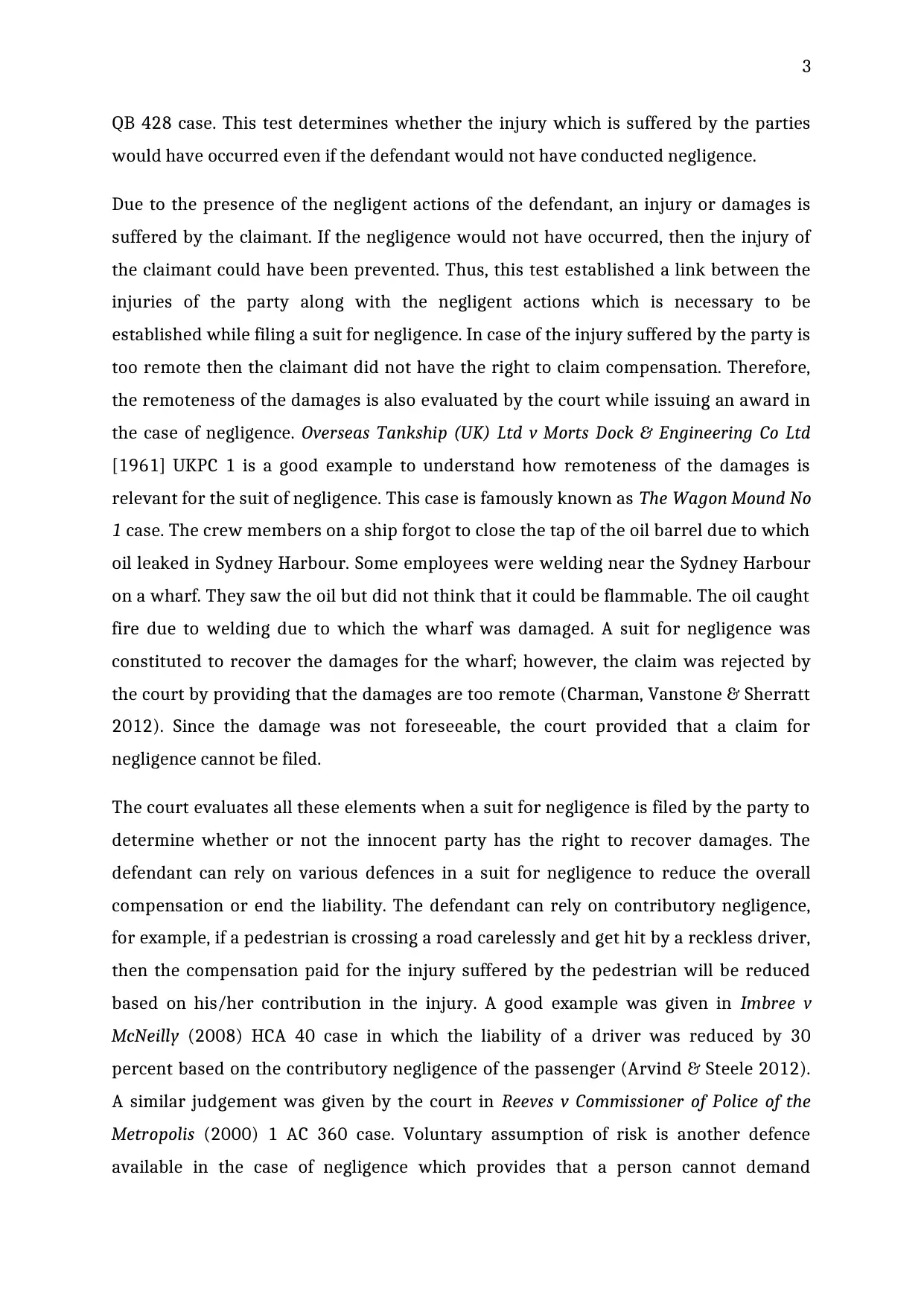
3
QB 428 case. This test determines whether the injury which is suffered by the parties
would have occurred even if the defendant would not have conducted negligence.
Due to the presence of the negligent actions of the defendant, an injury or damages is
suffered by the claimant. If the negligence would not have occurred, then the injury of
the claimant could have been prevented. Thus, this test established a link between the
injuries of the party along with the negligent actions which is necessary to be
established while filing a suit for negligence. In case of the injury suffered by the party is
too remote then the claimant did not have the right to claim compensation. Therefore,
the remoteness of the damages is also evaluated by the court while issuing an award in
the case of negligence. Overseas Tankship (UK) Ltd v Morts Dock & Engineering Co Ltd
[1961] UKPC 1 is a good example to understand how remoteness of the damages is
relevant for the suit of negligence. This case is famously known as The Wagon Mound No
1 case. The crew members on a ship forgot to close the tap of the oil barrel due to which
oil leaked in Sydney Harbour. Some employees were welding near the Sydney Harbour
on a wharf. They saw the oil but did not think that it could be flammable. The oil caught
fire due to welding due to which the wharf was damaged. A suit for negligence was
constituted to recover the damages for the wharf; however, the claim was rejected by
the court by providing that the damages are too remote (Charman, Vanstone & Sherratt
2012). Since the damage was not foreseeable, the court provided that a claim for
negligence cannot be filed.
The court evaluates all these elements when a suit for negligence is filed by the party to
determine whether or not the innocent party has the right to recover damages. The
defendant can rely on various defences in a suit for negligence to reduce the overall
compensation or end the liability. The defendant can rely on contributory negligence,
for example, if a pedestrian is crossing a road carelessly and get hit by a reckless driver,
then the compensation paid for the injury suffered by the pedestrian will be reduced
based on his/her contribution in the injury. A good example was given in Imbree v
McNeilly (2008) HCA 40 case in which the liability of a driver was reduced by 30
percent based on the contributory negligence of the passenger (Arvind & Steele 2012).
A similar judgement was given by the court in Reeves v Commissioner of Police of the
Metropolis (2000) 1 AC 360 case. Voluntary assumption of risk is another defence
available in the case of negligence which provides that a person cannot demand
QB 428 case. This test determines whether the injury which is suffered by the parties
would have occurred even if the defendant would not have conducted negligence.
Due to the presence of the negligent actions of the defendant, an injury or damages is
suffered by the claimant. If the negligence would not have occurred, then the injury of
the claimant could have been prevented. Thus, this test established a link between the
injuries of the party along with the negligent actions which is necessary to be
established while filing a suit for negligence. In case of the injury suffered by the party is
too remote then the claimant did not have the right to claim compensation. Therefore,
the remoteness of the damages is also evaluated by the court while issuing an award in
the case of negligence. Overseas Tankship (UK) Ltd v Morts Dock & Engineering Co Ltd
[1961] UKPC 1 is a good example to understand how remoteness of the damages is
relevant for the suit of negligence. This case is famously known as The Wagon Mound No
1 case. The crew members on a ship forgot to close the tap of the oil barrel due to which
oil leaked in Sydney Harbour. Some employees were welding near the Sydney Harbour
on a wharf. They saw the oil but did not think that it could be flammable. The oil caught
fire due to welding due to which the wharf was damaged. A suit for negligence was
constituted to recover the damages for the wharf; however, the claim was rejected by
the court by providing that the damages are too remote (Charman, Vanstone & Sherratt
2012). Since the damage was not foreseeable, the court provided that a claim for
negligence cannot be filed.
The court evaluates all these elements when a suit for negligence is filed by the party to
determine whether or not the innocent party has the right to recover damages. The
defendant can rely on various defences in a suit for negligence to reduce the overall
compensation or end the liability. The defendant can rely on contributory negligence,
for example, if a pedestrian is crossing a road carelessly and get hit by a reckless driver,
then the compensation paid for the injury suffered by the pedestrian will be reduced
based on his/her contribution in the injury. A good example was given in Imbree v
McNeilly (2008) HCA 40 case in which the liability of a driver was reduced by 30
percent based on the contributory negligence of the passenger (Arvind & Steele 2012).
A similar judgement was given by the court in Reeves v Commissioner of Police of the
Metropolis (2000) 1 AC 360 case. Voluntary assumption of risk is another defence
available in the case of negligence which provides that a person cannot demand
Paraphrase This Document
Need a fresh take? Get an instant paraphrase of this document with our AI Paraphraser
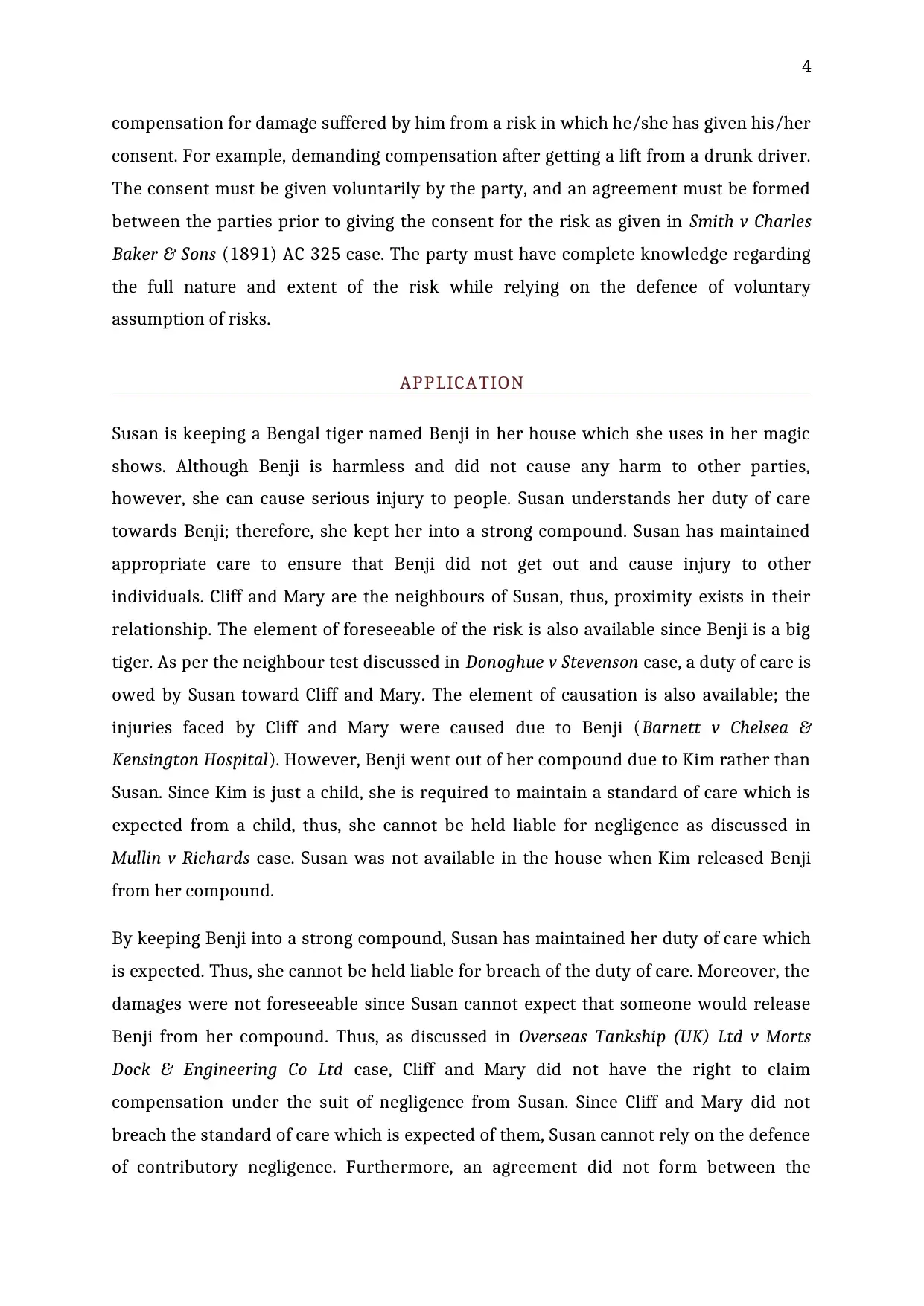
4
compensation for damage suffered by him from a risk in which he/she has given his/her
consent. For example, demanding compensation after getting a lift from a drunk driver.
The consent must be given voluntarily by the party, and an agreement must be formed
between the parties prior to giving the consent for the risk as given in Smith v Charles
Baker & Sons (1891) AC 325 case. The party must have complete knowledge regarding
the full nature and extent of the risk while relying on the defence of voluntary
assumption of risks.
APPLICATION
Susan is keeping a Bengal tiger named Benji in her house which she uses in her magic
shows. Although Benji is harmless and did not cause any harm to other parties,
however, she can cause serious injury to people. Susan understands her duty of care
towards Benji; therefore, she kept her into a strong compound. Susan has maintained
appropriate care to ensure that Benji did not get out and cause injury to other
individuals. Cliff and Mary are the neighbours of Susan, thus, proximity exists in their
relationship. The element of foreseeable of the risk is also available since Benji is a big
tiger. As per the neighbour test discussed in Donoghue v Stevenson case, a duty of care is
owed by Susan toward Cliff and Mary. The element of causation is also available; the
injuries faced by Cliff and Mary were caused due to Benji (Barnett v Chelsea &
Kensington Hospital). However, Benji went out of her compound due to Kim rather than
Susan. Since Kim is just a child, she is required to maintain a standard of care which is
expected from a child, thus, she cannot be held liable for negligence as discussed in
Mullin v Richards case. Susan was not available in the house when Kim released Benji
from her compound.
By keeping Benji into a strong compound, Susan has maintained her duty of care which
is expected. Thus, she cannot be held liable for breach of the duty of care. Moreover, the
damages were not foreseeable since Susan cannot expect that someone would release
Benji from her compound. Thus, as discussed in Overseas Tankship (UK) Ltd v Morts
Dock & Engineering Co Ltd case, Cliff and Mary did not have the right to claim
compensation under the suit of negligence from Susan. Since Cliff and Mary did not
breach the standard of care which is expected of them, Susan cannot rely on the defence
of contributory negligence. Furthermore, an agreement did not form between the
compensation for damage suffered by him from a risk in which he/she has given his/her
consent. For example, demanding compensation after getting a lift from a drunk driver.
The consent must be given voluntarily by the party, and an agreement must be formed
between the parties prior to giving the consent for the risk as given in Smith v Charles
Baker & Sons (1891) AC 325 case. The party must have complete knowledge regarding
the full nature and extent of the risk while relying on the defence of voluntary
assumption of risks.
APPLICATION
Susan is keeping a Bengal tiger named Benji in her house which she uses in her magic
shows. Although Benji is harmless and did not cause any harm to other parties,
however, she can cause serious injury to people. Susan understands her duty of care
towards Benji; therefore, she kept her into a strong compound. Susan has maintained
appropriate care to ensure that Benji did not get out and cause injury to other
individuals. Cliff and Mary are the neighbours of Susan, thus, proximity exists in their
relationship. The element of foreseeable of the risk is also available since Benji is a big
tiger. As per the neighbour test discussed in Donoghue v Stevenson case, a duty of care is
owed by Susan toward Cliff and Mary. The element of causation is also available; the
injuries faced by Cliff and Mary were caused due to Benji (Barnett v Chelsea &
Kensington Hospital). However, Benji went out of her compound due to Kim rather than
Susan. Since Kim is just a child, she is required to maintain a standard of care which is
expected from a child, thus, she cannot be held liable for negligence as discussed in
Mullin v Richards case. Susan was not available in the house when Kim released Benji
from her compound.
By keeping Benji into a strong compound, Susan has maintained her duty of care which
is expected. Thus, she cannot be held liable for breach of the duty of care. Moreover, the
damages were not foreseeable since Susan cannot expect that someone would release
Benji from her compound. Thus, as discussed in Overseas Tankship (UK) Ltd v Morts
Dock & Engineering Co Ltd case, Cliff and Mary did not have the right to claim
compensation under the suit of negligence from Susan. Since Cliff and Mary did not
breach the standard of care which is expected of them, Susan cannot rely on the defence
of contributory negligence. Furthermore, an agreement did not form between the
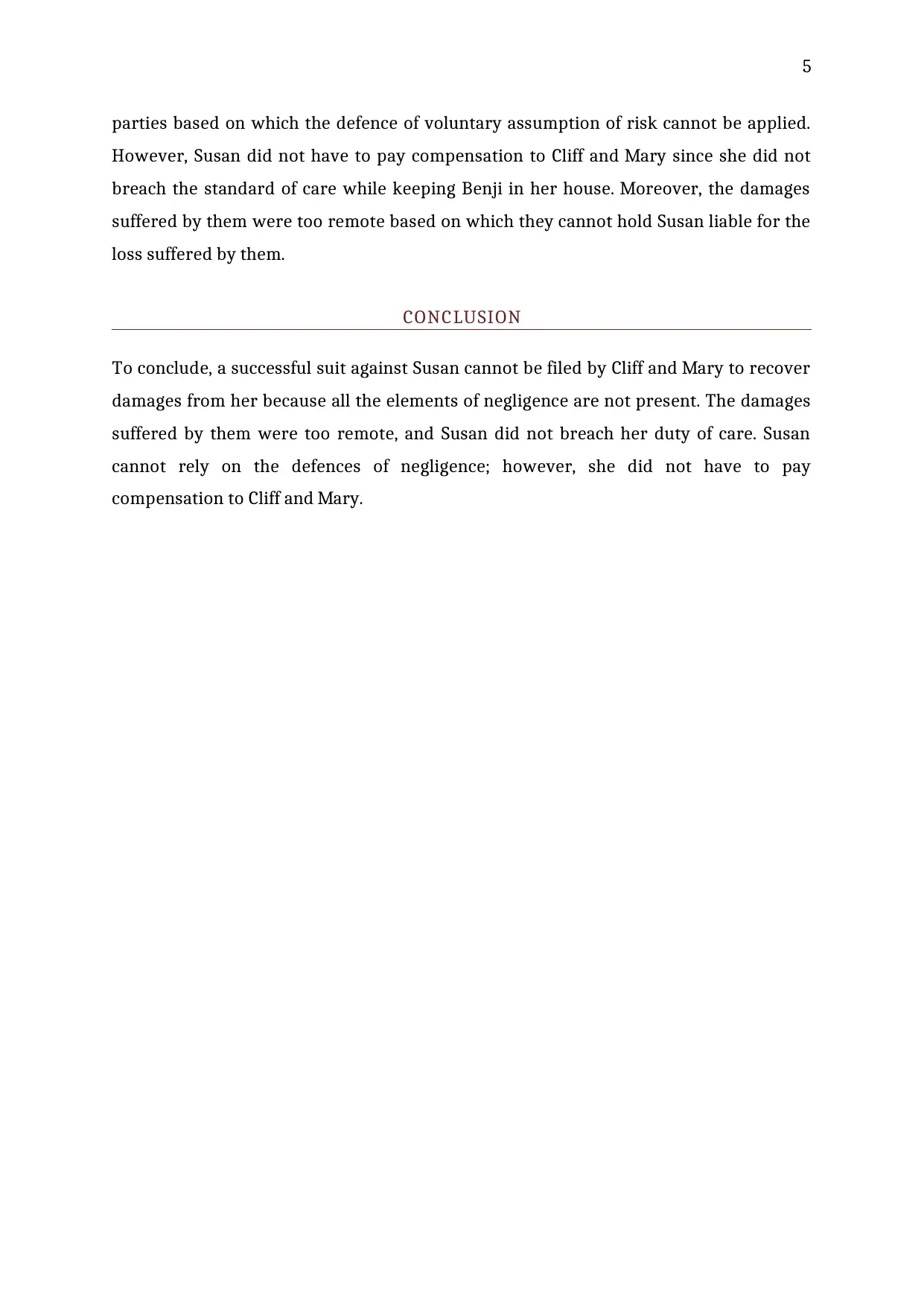
5
parties based on which the defence of voluntary assumption of risk cannot be applied.
However, Susan did not have to pay compensation to Cliff and Mary since she did not
breach the standard of care while keeping Benji in her house. Moreover, the damages
suffered by them were too remote based on which they cannot hold Susan liable for the
loss suffered by them.
CONCLUSION
To conclude, a successful suit against Susan cannot be filed by Cliff and Mary to recover
damages from her because all the elements of negligence are not present. The damages
suffered by them were too remote, and Susan did not breach her duty of care. Susan
cannot rely on the defences of negligence; however, she did not have to pay
compensation to Cliff and Mary.
parties based on which the defence of voluntary assumption of risk cannot be applied.
However, Susan did not have to pay compensation to Cliff and Mary since she did not
breach the standard of care while keeping Benji in her house. Moreover, the damages
suffered by them were too remote based on which they cannot hold Susan liable for the
loss suffered by them.
CONCLUSION
To conclude, a successful suit against Susan cannot be filed by Cliff and Mary to recover
damages from her because all the elements of negligence are not present. The damages
suffered by them were too remote, and Susan did not breach her duty of care. Susan
cannot rely on the defences of negligence; however, she did not have to pay
compensation to Cliff and Mary.
⊘ This is a preview!⊘
Do you want full access?
Subscribe today to unlock all pages.

Trusted by 1+ million students worldwide
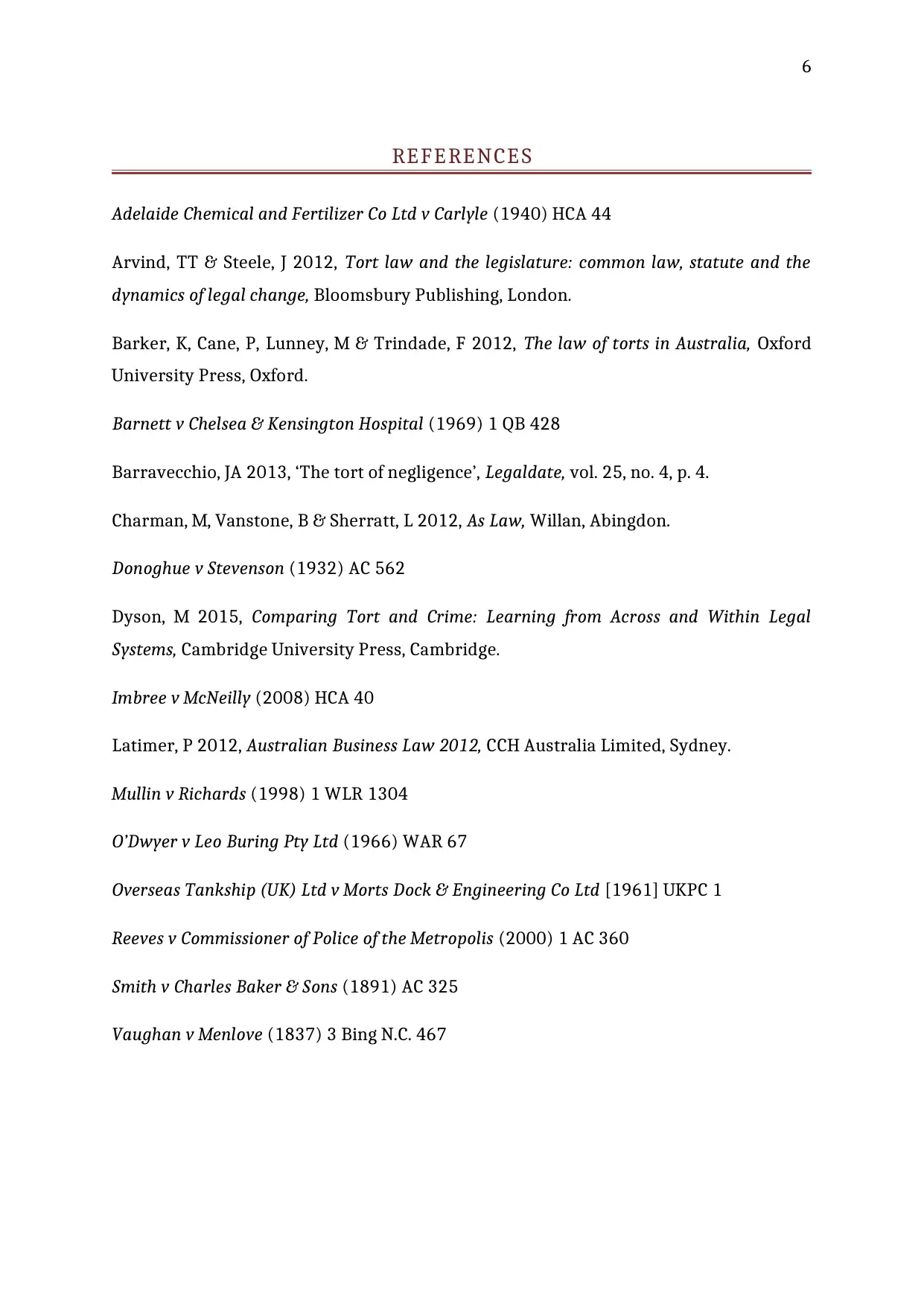
6
REFERENCES
Adelaide Chemical and Fertilizer Co Ltd v Carlyle (1940) HCA 44
Arvind, TT & Steele, J 2012, Tort law and the legislature: common law, statute and the
dynamics of legal change, Bloomsbury Publishing, London.
Barker, K, Cane, P, Lunney, M & Trindade, F 2012, The law of torts in Australia, Oxford
University Press, Oxford.
Barnett v Chelsea & Kensington Hospital (1969) 1 QB 428
Barravecchio, JA 2013, ‘The tort of negligence’, Legaldate, vol. 25, no. 4, p. 4.
Charman, M, Vanstone, B & Sherratt, L 2012, As Law, Willan, Abingdon.
Donoghue v Stevenson (1932) AC 562
Dyson, M 2015, Comparing Tort and Crime: Learning from Across and Within Legal
Systems, Cambridge University Press, Cambridge.
Imbree v McNeilly (2008) HCA 40
Latimer, P 2012, Australian Business Law 2012, CCH Australia Limited, Sydney.
Mullin v Richards (1998) 1 WLR 1304
O’Dwyer v Leo Buring Pty Ltd (1966) WAR 67
Overseas Tankship (UK) Ltd v Morts Dock & Engineering Co Ltd [1961] UKPC 1
Reeves v Commissioner of Police of the Metropolis (2000) 1 AC 360
Smith v Charles Baker & Sons (1891) AC 325
Vaughan v Menlove (1837) 3 Bing N.C. 467
REFERENCES
Adelaide Chemical and Fertilizer Co Ltd v Carlyle (1940) HCA 44
Arvind, TT & Steele, J 2012, Tort law and the legislature: common law, statute and the
dynamics of legal change, Bloomsbury Publishing, London.
Barker, K, Cane, P, Lunney, M & Trindade, F 2012, The law of torts in Australia, Oxford
University Press, Oxford.
Barnett v Chelsea & Kensington Hospital (1969) 1 QB 428
Barravecchio, JA 2013, ‘The tort of negligence’, Legaldate, vol. 25, no. 4, p. 4.
Charman, M, Vanstone, B & Sherratt, L 2012, As Law, Willan, Abingdon.
Donoghue v Stevenson (1932) AC 562
Dyson, M 2015, Comparing Tort and Crime: Learning from Across and Within Legal
Systems, Cambridge University Press, Cambridge.
Imbree v McNeilly (2008) HCA 40
Latimer, P 2012, Australian Business Law 2012, CCH Australia Limited, Sydney.
Mullin v Richards (1998) 1 WLR 1304
O’Dwyer v Leo Buring Pty Ltd (1966) WAR 67
Overseas Tankship (UK) Ltd v Morts Dock & Engineering Co Ltd [1961] UKPC 1
Reeves v Commissioner of Police of the Metropolis (2000) 1 AC 360
Smith v Charles Baker & Sons (1891) AC 325
Vaughan v Menlove (1837) 3 Bing N.C. 467
1 out of 7
Related Documents
Your All-in-One AI-Powered Toolkit for Academic Success.
+13062052269
info@desklib.com
Available 24*7 on WhatsApp / Email
![[object Object]](/_next/static/media/star-bottom.7253800d.svg)
Unlock your academic potential
Copyright © 2020–2025 A2Z Services. All Rights Reserved. Developed and managed by ZUCOL.




